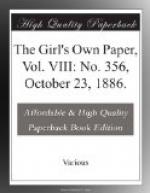It is always better to model direct from nature—and for this reason. By taking a leaf and pressing it into a piece of clay, and marking it round with a darning-needle, you get the exact shape of the leaf, and by pulling off the leaf you can bend the clay impression into any form you like, and put it upon your clay plaque or vase, pressing it into the curve you wish it to take. A little very wet clay should be put on back of leaf, to ensure it sticking to plaque. I have taken as my illustration (fig. 2) the garden poppy, and if I were modelling it direct from nature, I should first of all roll out a strip of clay for the stem, and put this on the plaque so that it makes a graceful curve. Strip off the leaves one by one, and take impressions in clay, and then fasten them to plaque, following the natural growth, and yet arranging them so that the leaves fall into their places agreeably. The back leaves, instead of being modelled, might be just marked in outline on the plaque itself. This will give depth to the design. The leaves should not be put on the plaque flatly, but should be bent and twisted as is necessary to suggest the growth of nature. The flower will present the greatest difficulty, as the serrated edges of the petals must be carefully done.
[Illustration: Fig. 3.—A vase.]
In the case of flowers like chrysanthemums, it is necessary to build up the most prominent flower solidly in clay, putting on the outer petals separately. The back flower can have the near petals modelled, while the distant ones can be just indicated on plaque with incised lines. Don’t attempt to copy every petal in clay, which is an impossibility, but try and get the general effect of the flower in your modelling. Take the prominent petals first, and put them on in their proper positions, and the less important petals can then be filled in in the intervening spaces. This is the plan to adopt in all intricate work. Put down your principal forms first of all, and you will have little difficulty in getting in the less important ones, for the principal forms act as measuring points to the rest of the work, and enable you to preserve that proportion between the various parts of the design which is essential in all good designs. It is necessary in modelling to simplify nature somewhat, for we cannot imitate nature in clay. What we have to do is to seize upon the principal points, the curves of the stems, the position, form, and characteristics of the flowers and leaves, and put them down intelligently and in as telling a manner as possible. Let the work dry carefully before having it fired, and you can either finish it up in colours, and have it glazed, or let it remain as it is. I often used to use my Barbotine colours (see articles on “Barbotine Painting,” in Nos. 440 and 584, vol. iv., of the G.O.P.) for colouring modelled work and glazed it with my soft glaze. I have also sent some work to the potteries, and had a coloured glaze put over the whole work. I may here say that much may be learnt by studying good modelled work, and even copying some stone or wood carving in clay. The pottery of Della Robbia and Palissy should be studied whenever the student has the opportunity of so doing.




